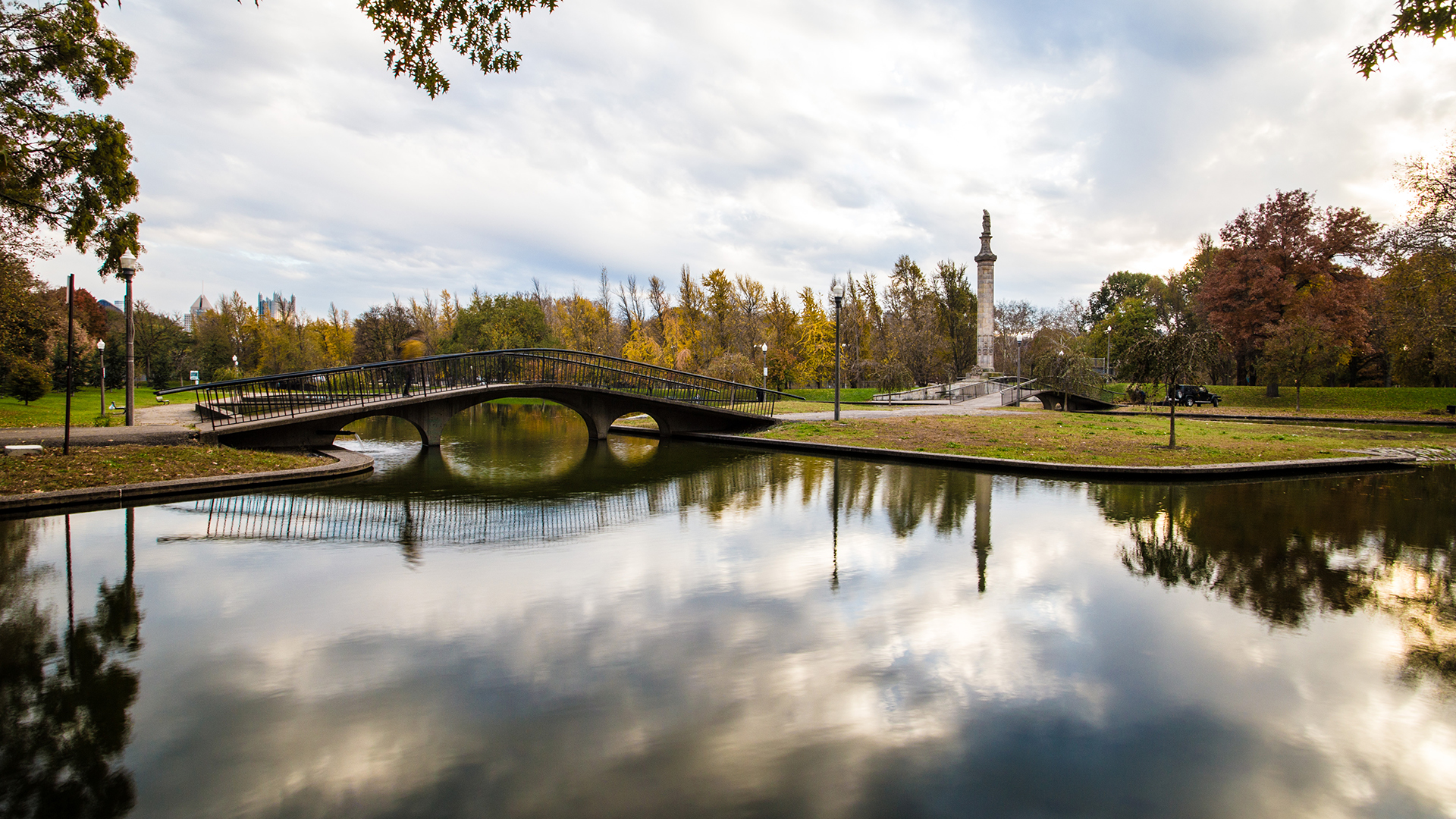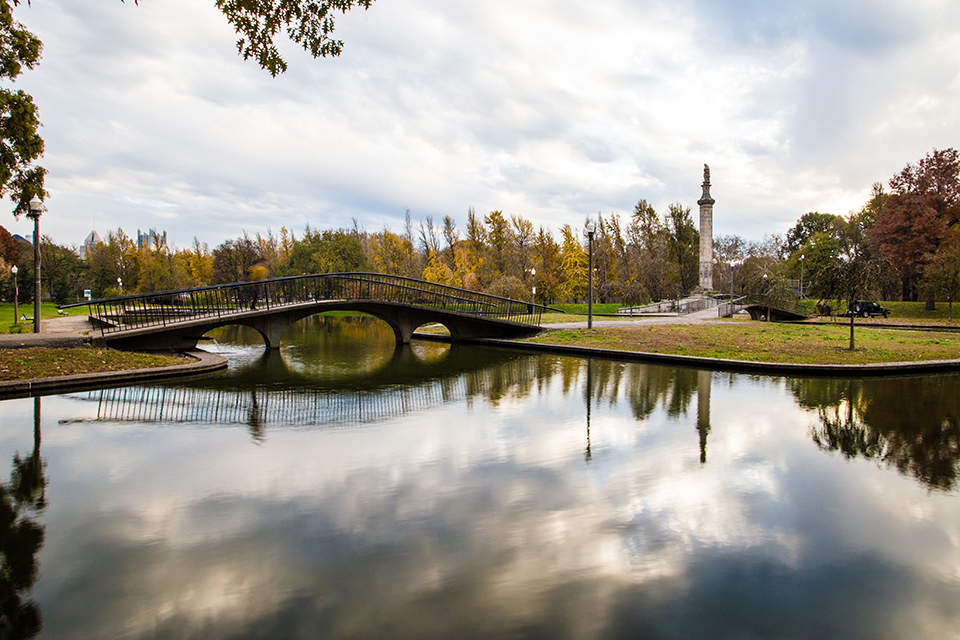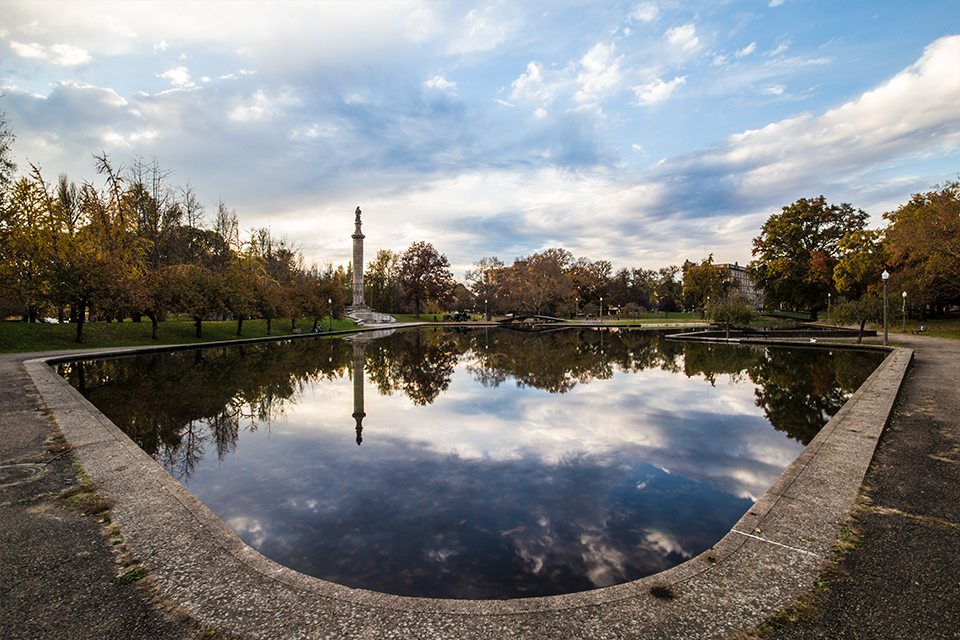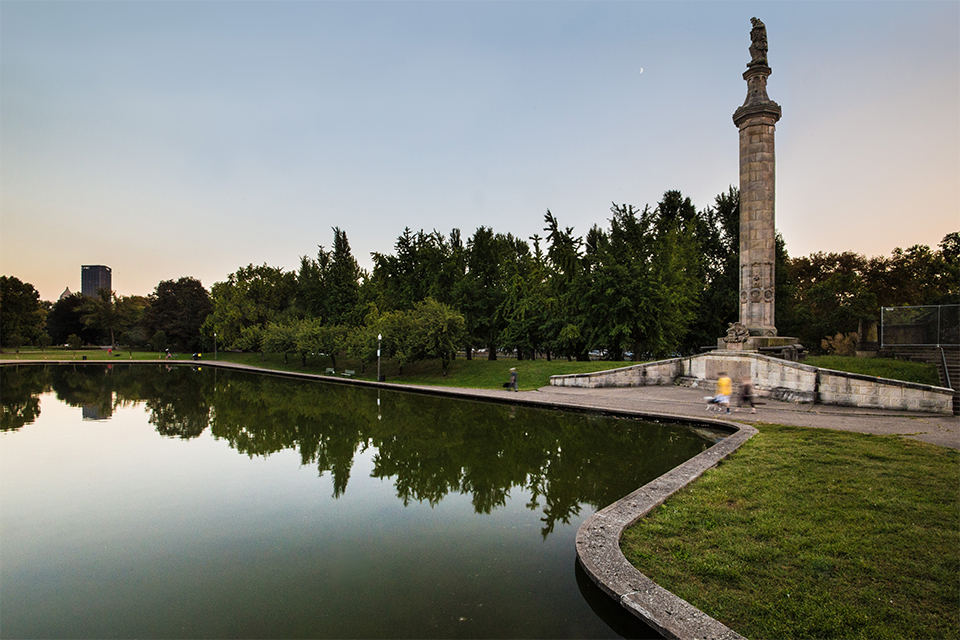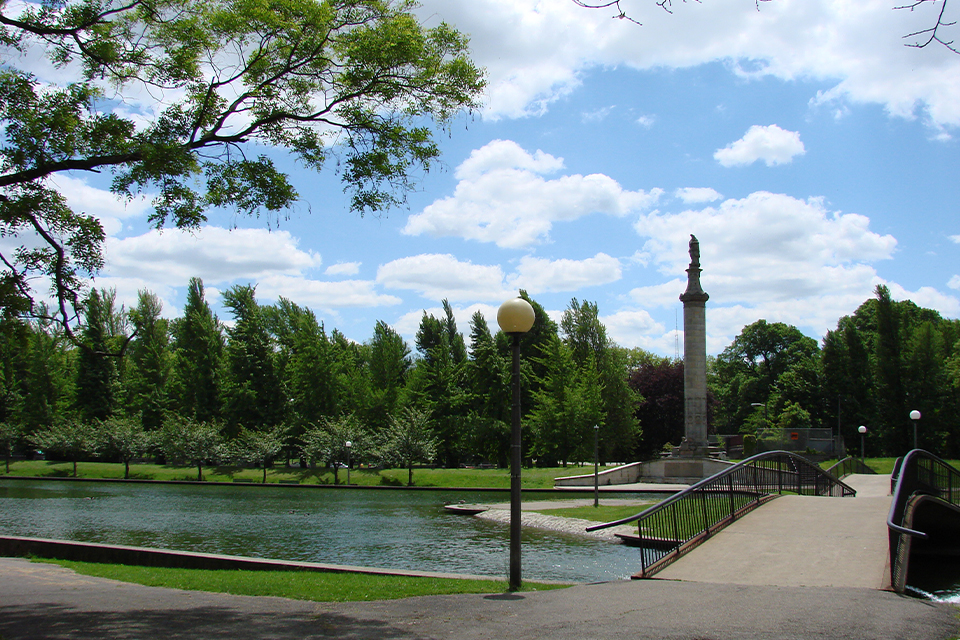First conceived in 1868 as a pastoral addition to Allegheny Commons – the oldest mapped parkland in Pittsburgh – this body of water was converted into a recreational lake in the twentieth century. It provided city residents with a place for swimming, boating, and skating. However, the once popular lake was drained in 1930 and became a dumping site for scrap metal during World War II. After the war, public and private interests in Pittsburgh combined in an effort called the “Pittsburgh Renaissance” to revitalize the city’s downtown area. The Urban Redevelopment Authority was established, which hired the landscape architecture firm Simonds & Simonds to redesign Lake Elizabeth, along with the greater Allegheny Commons, in 1966.
Background
John Simonds aimed to fulfill two underlying objectives with the park: to “convert the Commons into a more useable and safer open space,” and to create a “focal point and stimulus to the revitalization of the lower north-side” of the city. He designed a concrete-edged, trapezoidal water feature, combining a V-shaped lake with a fountain and a chain of rectilinear lagoons. Stream boulders were embedded in the concrete lake bottom and a pair of pedestrian bridges built to connect to the lake’s peninsular island. Simonds’ Modernist bridge sits immediately adjacent to the Soldier’s Monument, a Civil War memorial dating to the 1860s. Only one phase of construction was completed in 1967, leaving unrealized the multi-level, interlocking pools, the island’s water jets, and the boathouse in Simonds’ plan.
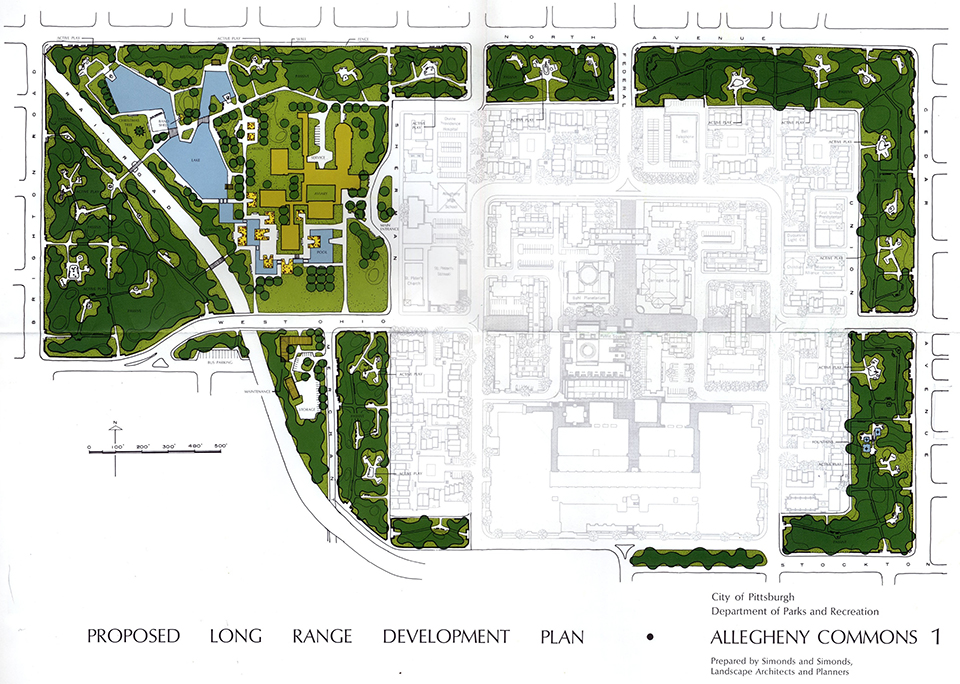 Plan of Proposed Long Range Development Plan, Allegheny Commons by Simonds & Simonds, 1966, courtesy Charles A. Birnbaum.
Plan of Proposed Long Range Development Plan, Allegheny Commons by Simonds & Simonds, 1966, courtesy Charles A. Birnbaum.
Succumbing to resource constraints and slowly falling into disrepair, the park eventually became unsafe and a haven for crime. A consortium of community members came together in 1999 to preserve and renew the park, forming the Allegheny Commons Initiative under the care of the Northside Leadership Conference. Pressley Associates, a Cambridge, MA-based firm, produced a master plan in 2002, involving community members, experts in the fields of history, architecture, and park maintenance, as well as stakeholder organizations and the City of Pittsburgh. The resulting Allegheny Commons Master Plan called for the preservation of the Simonds & Simonds landscape and the rehabilitation of the greater Allegheny Commons, including the conversion of Lake Elizabeth from a stagnant water feature to an inviting body of water with a natural filtration system that would rely on rainwater as its primary source.
Unfortunately, the financial distress of the City of Pittsburgh meant that municipal support for repairs and maintenance continued to be deferred. Well-intentioned repairs were made without regard to the original design intent. By 2008 concrete spalling was evident throughout the Modernist lake feature; the bridges were marked with exposed steel rebar and similar degradation; the pump pit for the lake had been welded shut and rendered useless, leaving no re-circulation system; and the lake’s two drain systems had been covered with a generic steel mesh.
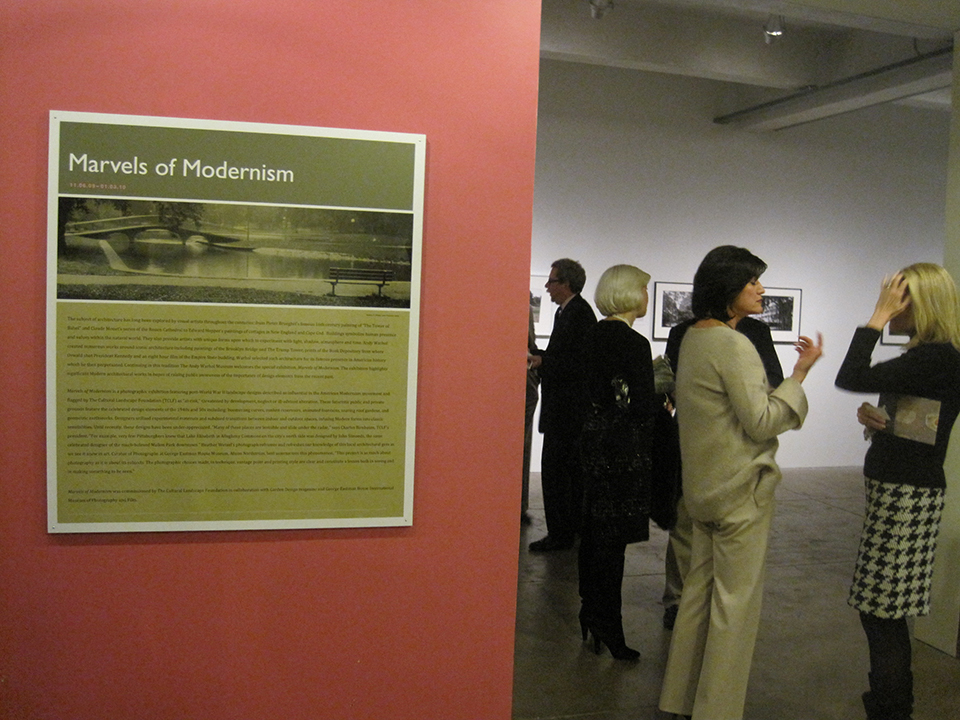
Marvels of Modernism Exhibition, The Andy Warhol Museum, Pittsburgh, PA, 2009, courtesy The Cultural Landscape Foundation.
Advocacy and Engagement
TCLF enrolled Lake Elizabeth in the 2008 thematic Landslide report, Marvels of Modernism (along with Manhattan Square Park, Heritage Park Plaza, Mill Creek Canyon Earthworks, Miller Garden, and Peavey Plaza, also included in this year’s report). TCLF’s partners included the George Eastman Center of Photography and Film, in Rochester, N.Y., and Garden Design, which with TCLF co-curated a traveling exhibition of newly commissioned photographs of the sites, including Heather F. Wetzel’s ruby ambrotype of Allegheny Common’s Lake Elizabeth (visually uniting the 1960s Modernist design with its nineteenth-century Picturesque setting). Design Within Reach and regional American Society of Landscape Architects chapters (including New York, Chicago, Northern California, Illinois, Pennsylvania, and others) co-hosted traveling signboard exhibits that were displayed in more than a dozen cities. The exhibit drew national media attention, including from The New York Times. It travelled to the Warhol Museum in Pittsburgh in November 2009, where its viewing coincided with the symposium, hosted by TCLF, The Hunter and Philosopher: John O. Simonds Pioneer Landscape Architect. The event also included an opening reception at the Warhol, along with free walking tours of Lake Elizabeth and Mellon Square (the latter another signature Simonds project). The tours were guided by Marion Pressley and Patricia O’Donnell, respectively, the landscape architects who had overseen the preservation planning work of these spaces.
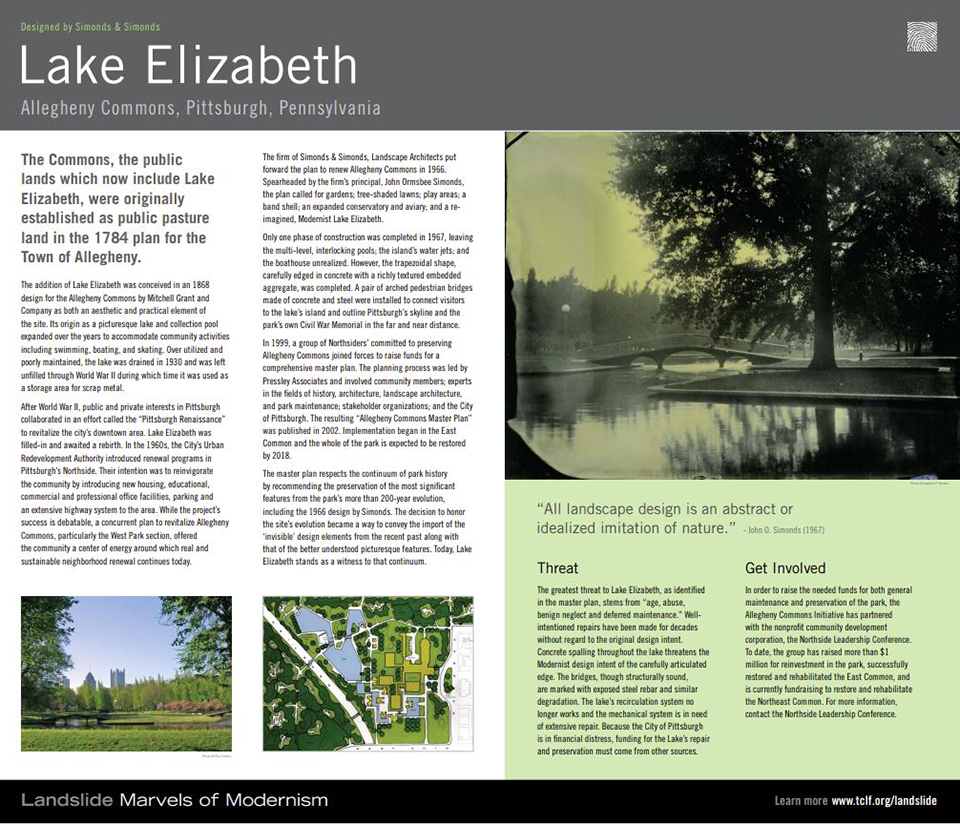 Lake Elizabeth Signboard, Marvels of Modernism, 2008, courtesy The Cultural Landscape Foundation.
Lake Elizabeth Signboard, Marvels of Modernism, 2008, courtesy The Cultural Landscape Foundation.
Allegheny Commons was listed in the National Register of Historic Places in 2013, with significance in landscape architecture and miraculously having a period of significance that spanned more than a century of design, from 1850-1974.
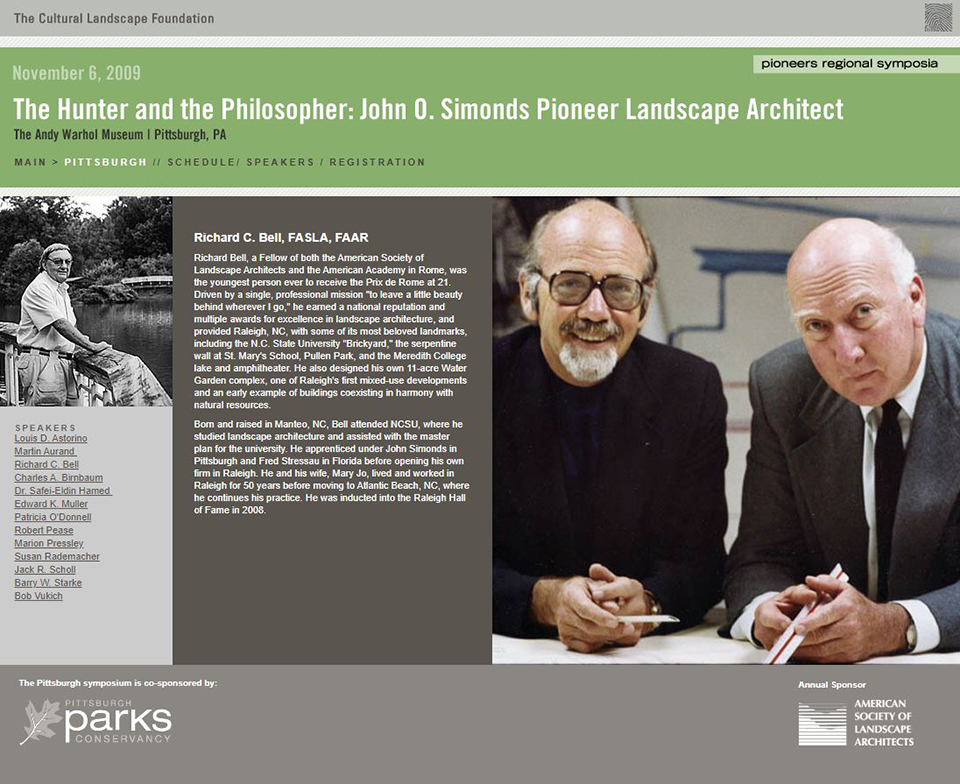 Speaker Profile for Richard C. Bell, FASLA, FAAR, The Hunter and Philosopher: John O. Simonds Pioneer Landscape Architect, The Andy Warhol Museum, Pittsburgh, PA, 2009, courtesy The Cultural Landscape Foundation.
Speaker Profile for Richard C. Bell, FASLA, FAAR, The Hunter and Philosopher: John O. Simonds Pioneer Landscape Architect, The Andy Warhol Museum, Pittsburgh, PA, 2009, courtesy The Cultural Landscape Foundation.
Following this initial burst of activity, the Pittsburgh Parks Conservancy, the City of Pittsburgh, Northside Leadership Conference, and the Allegheny Commons Initiative formed a coalition to accelerate the restoration of the park and to spur continued revitalization of the Northside community. In 2018 this group completed the Allegheny Commons Action Plan, with LaQuatra Bonci Associates, which presented strategies for implementing the 2002 Master Plan, informed by additional study of economic context, ecological services, and neighborhood connectivity. The conservancy restored the Patricia Rooney Memorial Fountain, also known as the Northeast Fountain, in 2019. The two-million-dollar project, comprising nearly one city block, included reconstruction of the fountain and surrounding gardens, and installation of new pathways and signage, benches, lighting, and other park amenities.
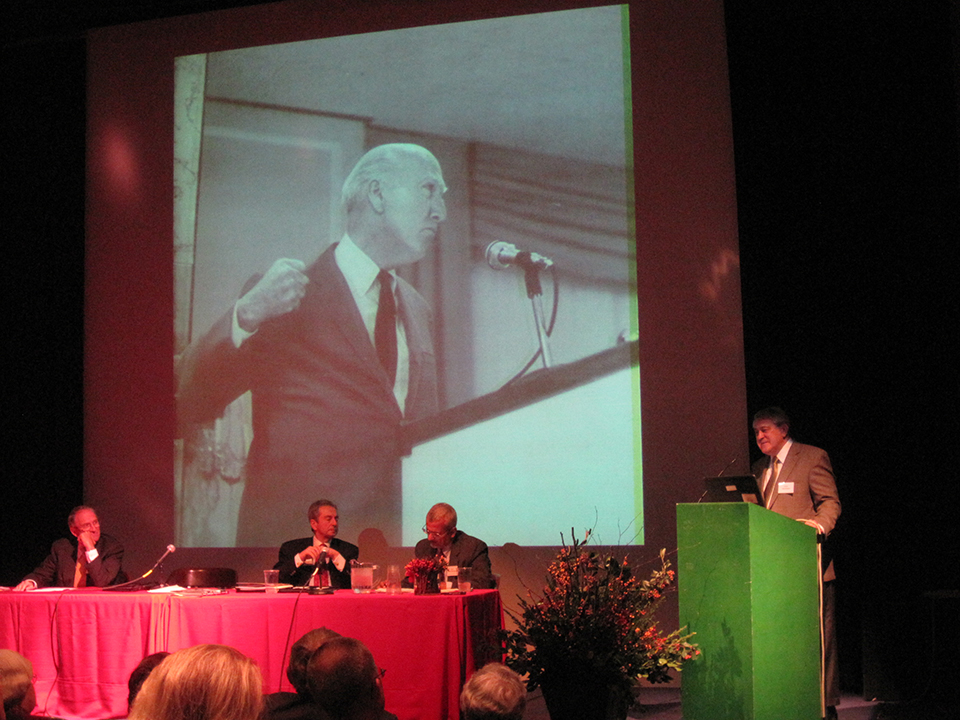 The Hunter and Philosopher: John O. Simonds Pioneer Landscape Architect, The Andy Warhol Museum, Pittsburgh, PA, 2009, courtesy The Cultural Landscape Foundation.
The Hunter and Philosopher: John O. Simonds Pioneer Landscape Architect, The Andy Warhol Museum, Pittsburgh, PA, 2009, courtesy The Cultural Landscape Foundation.
Next, the conservancy rebuilt the wide Promenade path along the north end of the park, from Federal Street to the Rooney Memorial Fountain, furnishing it with benches and energy-efficient period lighting. Excess pavement was removed, and connecting paths were adjusted to align with intersections. As part of the project, crews planted 100 trees along the Promenade. The first phase of this project was completed in July 2021, costing $1.1 million. The second phase began in June 2023 and will address Federal Street to the George Washington Monument, a focal point of the park since 1891. The conservancy is dedicated to working in harmony with the park’s significant history while enhancing accessibility for all – goals directly aligned with Simonds’ earlier vision for the park.
Selected Resources
“Go Forth into a Modernist Landscape”
The Hunter and the Philosopher: John O. Simonds Pioneer Landscape Architect Symposium
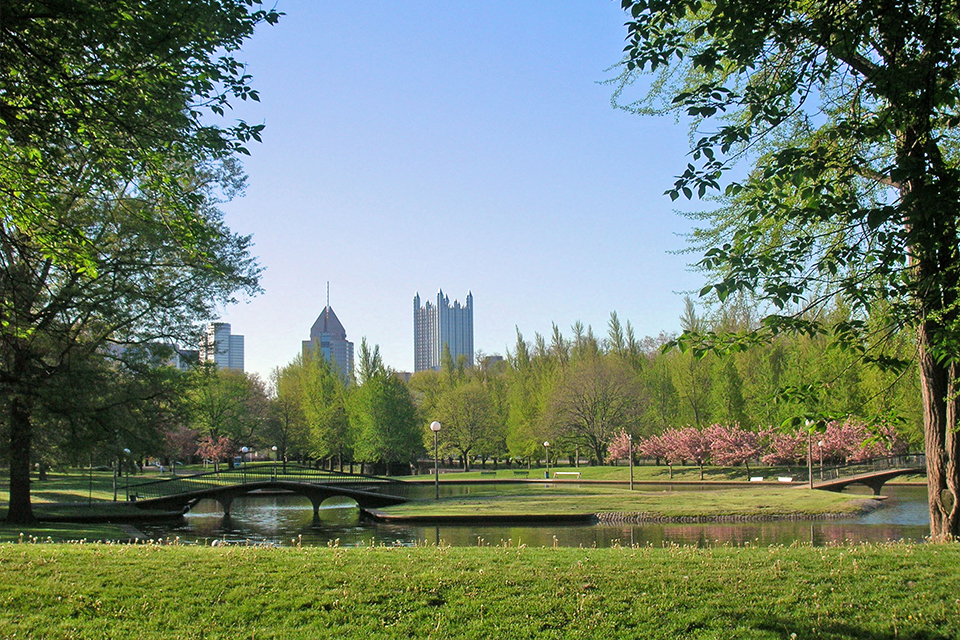
-
Allegheny Commons - Lake Elizabeth, Pittsburgh, PA, 2013. Photo by Paul Tellers.
